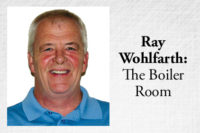John was a custodian for a local school district. We used to call him “20 Questions” because he would constantly ply us with questions about the boilers when we would perform the annual service. He would jokingly ask how many of the 20 questions he would have left.
After many years as the custodian, John was promoted to the maintenance department. During the first year as a maintenance technician, one of the boilers at the high school malfunctioned and covered the tubes with black soot. Rather than call us, he cleaned the boiler tubes himself with a wire brush. If you ever cleaned a sooted boiler, you will know that the soot goes everywhere. It will embed itself in your skin and no amount of soap will remove it. It has to eventually wear away.
The second, more dangerous characteristic of soot is that it is very flammable. While John was cleaning the boiler tubes, the soot coated his right sleeve and shirt. The wire brush he was using sparked, causing the soot to ignite. John suffered third-degree burns on his arm and second-degree burns on his face. He was off work for months.
I confess that boilers and boiler safety intrigue me. I have only had one close call in all my years of servicing and sales of commercial boilers. I was starting a new boiler and the installer had wired the gas valve to the line voltage terminal by mistake and I missed it. I opened the manual gas valve and the boiler filled with natural gas during the 90-second prepurge. The prepurge is used to flush the boiler and flue of any combustible materials before ignition.
When a spark was generated by the ignition electrode, the gas ignited. A loud boom shook the entire building. The welded flue blew out of the boiler and adjacent water heater. My ears were ringing and I was covered in dirt and dust. The building occupants ran into the boiler room to see what happened. The visibility in the boiler room was nil due to the dust.
Causes of boiler accidents
What are some of the causes of boiler accidents? Well, it depends upon whom you ask. For instance, when the National Board of Boiler and Pressure Vessel Inspectors used to track and publish its annual Boiler Incident Report, the leading cause of boiler accidents was attributed to operator error or poor maintenance. The above examples are an illustration of operator (human) error. The second-leading cause was the low-water cutoff.
The NBBPVI list of boiler accident causes (in order) is as follows:
1. Operator error or poor maintenance;
2. Low-water cutoff;
3. Unknown;
4. Limit controls;
5. Burner failure;
6. Faulty design or fabrication;
7. Improper installation;
8. Safety valve; and
9. Improper repair.
Since 2003, the Occupational Safety and Health Administration has been tracking boiler accidents. It reports that the leading cause of boiler safety violations is controls and not human error. The OSHA list of boiler accident causes (in order) is:
1. Controls;
2. Piping;
3. Relief valves; and
4. Components.
Whether the cause of a boiler accident is caused by human error or system components, boilers are relatively safe due to redundant safety controls. As a matter of fact, a home forced-air furnace is much more dangerous than a commercial boiler.
ASME CSD1 2009 boiler code now requires that a “systematic and thorough maintenance program shall be established and performed.” It further states that results of the testing shall be recorded and “any defects shall be brought to the attention of the boiler owner and shall be corrected immediately.” This alone could greatly reduce the chances of a boiler accident.
The low-water cutoff is the leading mechanical cause of boiler accidents and should be tested on a regular basis. The low-water cutoff uses either a probe or float to verify the elevation of the water inside the boiler. Refer to the manufacturer’s instructions when testing the controls.
When testing the low-water cutoff on a steam boiler, I prefer to simulate actual jobsite conditions during the test. I will slowly drain the water from the boiler and note the level where the burner shuts off. If the control is a duplex one that also operates the feed water valve or pump, I will verify the proper water elevations at which the pump starts or stops.
Use caution when draining the low-water cutoff as “condensate-induced water hammer”could occur, which is very dangerous. Condensate-induced water hammer happens when steam is surrounded and quickly condensed by cool water.
Many boiler inspectors require that the low-water cutoff be disassembled for inspection yearly. Some manufacturers even recommend the replacement of the control every five years.
Testing hydronic system low-water cutoffs are a bit more tricky as the system is filled with water and a low-water condition may not be able to be simulated. Some of the low-water cutoffs for hydronic systems have a test button.
Who is at fault?
In some instances, the person who worked on the boiler prior to the accident could be held criminally responsible for the accident. For example, an installer in the United Kingdon who improperly installed a boiler that subsequently caused the death of a famous model was found guilty of manslaughter. His crime was that he did not install the screws in the flue pipe to secure the pipe in place and the flue came apart.
In Canada, the federal government pleaded guilty in the death of a worker who was killed in a boiler room. It will not be long before technicians in the United States could face criminal charges for their work.
According to John F. Porcella, chief boiler inspector of West Virginia, and other boiler inspectors, flammable items are often stored inside a boiler room and this is problematic. It is not uncommon to find lawn mowers, paper towels, cleaning solvents, dust mops, snow blowers and cans of gasoline stored inside the boiler room.
A school in our area stored student records in cardboard boxes next to the boilers and school officials were surprised when the records caught on fire.
Another danger inside a boiler room is when the combustion air openings are blocked or restricted.
Boiler inspectors can provide a wealth of information for safer operation inside boiler rooms. In most instances, all you have to do is ask. These professionals have been thoroughly trained and have seen many boiler rooms. It is a good idea to have someone with that type of experience as an ally.





